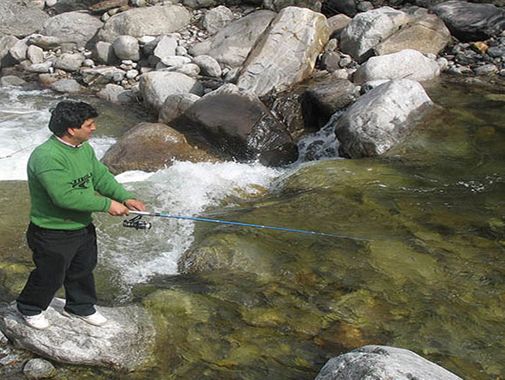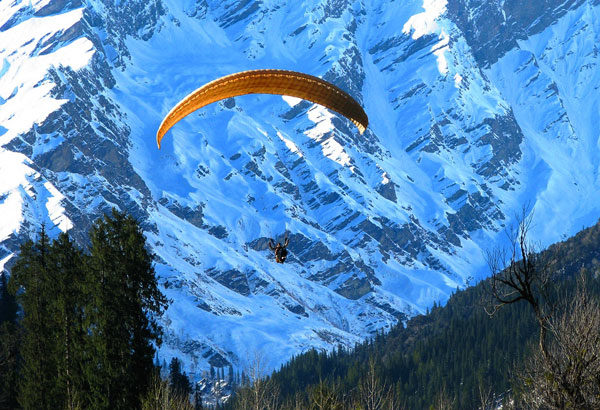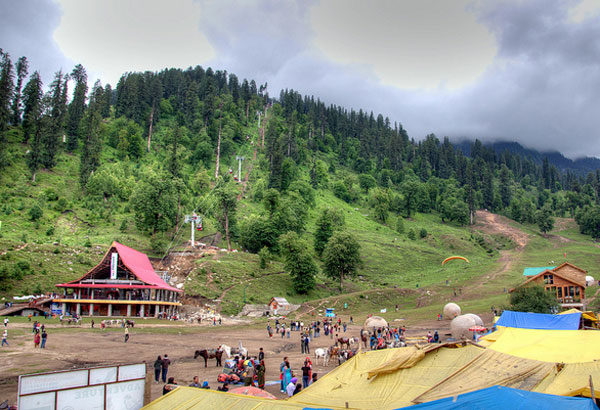Introduction to Great Himalayan National Park (GHNP)
Great Himalayan National Park : Himachal Pradesh has taken the lead in the advocating and implementing environmental conservation. The Great Himalayan National Park situated in the eastern catchment area of the Beas is a biologically rich terrain that is complemented by scenery. The Tirthan river valley has always been a popular hunting ground as it abounds with big game. Due to the threat of hunting,Tirthan was notified as sanctuary in 1976, mush before the idea of the Great Himalayan National Park was floated.
Nature worship and the conservation ethic have been an integral part of Indian thought and traditions and its also followed by India’s Himalayan neighbors. For centuries, the country has nurtured the philosophy of the oneness of life, the tradition that humankind is a part of nature and one should look upon all creation with the eyes of a friend.
It is tragic that in recent years, the mad pursuit for material ends has created in India and elsewhere a situation in which progress has become synonymous with exploitation of nature in all its manifestations. Today the entire Himalayan range, with its rich and unique biological diversity, is facing a deep crisis and is in the danger being destroyed. It is being relentlessly denuded of its rich forest cover. Fortunately, this has been led to some realization, and now the beginnings of a new awakening about human responsibility towards nature are discernible.
“The Himalayas”
The Skanda Puranas have held Himalayas and Himachal Pradesh in high esteem and reverence. “As the due is dried up by the morning sun, so are the sins of mankind by the site of Himachal”.
The Himalayas, the youngest, loftiest of all the mountains in the world and embracing seven out of the ten highest peaks, sprawl approximately 2,560-kms from North western to the south eastern along with its extension in North eastern India and has breadth from 250-km to 400-km. States of India namely Arunachal Pradesh, Nagaland, Tripura, Manipur, Meghalaya, Mizoram, Sikkim, Himachal Pradesh Jammu and Kashmir, Uttaranchal and Darjeeling district of West Bengal are located in Himalayas.
The Himalayan Landscapes
The undulating Himalayas welcome with bottle green shrubbery in the foothills of Shivalik Ranges, crescent shaped, snow clad Dhauladhar over shadowed by the Pir Panjal and the Great Himalayan Ranges. The land is dotted by beautiful lakes and valleys located between an altitude of 350 metres and approximately 6,810 metres, intercepted by rivers and sprawling valleys. The forests, flora and fauna, wild life and natural scenic beauty with salubrious climate is a haven for the visitors.
The alpine land, spread over Lahaul and Spiti to Pangi valley, is an ardent destination for Alpinists and a feast of hedonic nature’s bounty. In Himalayas, medicinal herbs have been growing throughout nature kindness from the times immemorial. Adventure sport is another area of tourism activities, which yields greater scope for trekking, camping, mountaineering and skiing, etc.
Visiting The Land Of Gods
The fairs and festivals, customs and gatherings attended by the locals represent the unconcealed simple disposition and hospitable populace. To visit Himachal, by itself, is an experience of heritage. Himachal is popularly described as “Dev Bhumi”. The temples, churches, Gurdwaras, monasteries besides bearing testimony to the typical pieces of architecture and woodcarving enjoy the international fame.
With several spurs and sub system, the Himalayas are a strong spine for the state of Himachal Pradesh in Northern India. They have also given the area an enormous geographical spectrum – and one that is unparalleled in the world. To sum up, it is truly said, “A sweeter and a lovelier land, framed in the prodigality of nature. The spacious world cannot afford to have again.”
Things Effecting NatureMountains, forests and pastures are the mothers of rivers that sustain life. Their catchment areas are the water basins for hydel projects and dams. Destroy the forests and one will find dams silting and going dry; hydel projects will remain a dream and drought a common occurrence. Scarcity of water will affect food production and there will be no answer to the frantic cries of the cities and villages for water between individuals, states and nations, and progress adversely affected due to lack of power.
In recent years trees have so badly lopped that they are left only with a crown of green top; herbal collections on massive scales by agents of drug plant owners; uncontrolled grazing by animals; forests set on fire by villagers to get better growth for grazing with no thought for wild animals and birds; fish being electrocuted in mountain streams; large forest areas encroached upon by farmers and tourism developers; forest rest houses demolished by ‘timber looters’; barren, hollowed out hillsides due to mining; murder of the majestic deodars by cutting a hollow at the base of the trunk and then setting it on fire.
Land, water and forests resources are being degraded and depleted at a galloping speed. With over-exploitation for agricultural purposes and to meet the ever-increasing demands of the cities, the sub-soil water is receding at an alarming rate. If the rivers too go dry, the holocaust can well be imagined. Deforestation will lead to desertification as is happening in parts of China where the desert sand dunes are spreading at the rate of 200-sq-kms per month.
Deforestation
Forests are critical for preserving the green covering on mountain soils. Extensive deforestation and grazing results in barren surface, soil erosion and porosity. The porous soil, during the monsoons and cloud bursts, soaks in water gets loosened and whole mountain sides slide down taking with them trees, farm lands, villages and finally damming the rivers-leaving behind barren scars on the mountains which will further increase erosion.
Most vulnerable to this kind of nature’s fury are the run-of-the-river schemes Hydel projects and big gravity dams especially when their catchment areas have been deforested. “Among mountains, I am the Himalaya” (Bhagvat Gita) – this was the pride with which our ancestors and sages looked up to the most beautiful, majestic and mighty snow-capped mountains. Today, however, the same Himalayas are the most degraded mountains in the world- a eco-disaster in the making. Wisdom is required not to plunder but to preserve.
It is time to wake up to this “last awakening call”, otherwise we are heading for the Himalayan eco-disaster and with it the “Last Bugle Call
Arrival at Manali, meet and greet with our representatives and transfer in to hotel. In the evening explore the mall road Manali. Overnight stay in hotel or cottage
1st Day : Manali to Gushaini : Early in the morning, after having breakfast, we proceed drive to Gushaini. Over night stay in guest house.
2nd Day : Gushaini To Kharaugcha ( 2,042 mtr ) : Next day , after freshen ,we start walk to next destination Kharagucha , where you can pitch the tent. Overnight we stay here
3rd Day : Kharagucha to Nara Thach :3,261 mtr) : After having breakfast we start trek from kharagucha to Nara Thach. Its is a gradual descent from kharagucha takes you to the river bank, Short of the guard hut at Rolla, cross over to the right bank. After two hours walking from rolla through the dense forest, reach the guard hut at Chalocha. The gorge is so narrow, you sometimes have to climb up on step ladders cut out from tree tunks. Climb onto the saddle on the ridge above to descend to the wild meadow of Nara(3,261 mtr) Camping on this meadow below the ridge you can see the summit of Srikand Mahadev.
4th Day: Nara Thach and Back To Camp: Next day we start trek in the meadows there are the ideal habitat for the Himalayan Tahr. Regarded as an intermediate between a goat-antelope and Goat, it is a well-built animal sporting a shaggy coat of the hari and curving horns. You can find another goat species on the cliff sides is the goral, smaller than the tahr and also you can find the serows grazing near by. Another intermediate between goat-antelopes and goats , the serow can be identified by the stocking-like lower half of its limbs. It is as big as the tahr. Even the common leopard on the apex of the food chain in these parts, is found there in summer. In the winter ,its retreats to the lower forests. An exploratory climb to the kabri meadow (3,900mtr) is highly recommended on this day. You could see the spectacle of the red giant flying squirrel gliding form on tree to anther trees. You could also see the musk deer foraging in the undergrowth. In the evening come back to base camp at Nara Thach . Over night we stay here.
5th Day :Nara Thach To Shanka Thach : Next day early in the morning after freshen we start trek to Nara Thach to Shanka Thach. The trail traverses the mountainside for an hour or so through extremely thick forest and then descends steeply to small side stream. Soon you arrive at the shepherd’s encampment at Rakhali.(2,895 mtrs). Follow the right bank of the Tirthan and then follow the river for an hour and a half to reach the campsite at Shanka Thach10,100 ft /3,078 mtrs. Over night we stay here.
6th Day: Shanka Thach to Bhiundwari Meadow :(12,000 ft/3,657 mtrs) : Next day , after freshen , we start trek from shanka Thach to Bhiundwari Meadow. A tricky trail over scree slopes prone to landslides, offer logs for the climber. A taxi walk leads to Majhauni, where the forest ends but the trail becomes deceptive. As the valley open up, the route passes over scree slopes and ice patches to reach the Tirth Meadow, carpeted with flowers, particularly fritillaries, anemones and obtuseloba. A short walk away is Bhiundwari (12,00ft/3,657 mtrs) at the junction of two valleys. The name of the camp is derived from a rock shelter, a ten minute walk from the camp. There Bhim, the pandava prince, meditated during his twelve –year exile.
7th Day: Camping At Bhiundwari: Early in the morning we start exploratory walk to Hans Kund, The sacred pool from where the Tirthan originates. A forty five minute walk brings you to the spot marked by saffron flags. The locals never camp there since it is held to sacred. The area around is typical snow leopard and brow bear territory. On the slopes around Hans kund, you could see hers of blue sheep, an intermediate between a goat and sheep with large curved horns, Horned Ibex can also be seen. Over night back to camp and stay here.
8th and 9th Day: Next day we start back to Gushaini via Shanka Thach , Nara Thach , Chalocha, and Kharaugcha. At a brisk pace you can be back at Gushaini on the afternoon on the ninth day. An alternate but extremely tough possibility is to clime on to the right ridge of the Tirthan valley, descend to the Sainj, and than go up similarly to jiwa and Parbati valley. But the require time ,experience, technical know how and a definite kink in the mind. An alternative route from Nara Thach takes one across the ridge to the Sainh valley over Lapah and Shangarh village. Two more days are needed for this trip, but make sure your guide is familiar with the route. Over night stay in Guest house
Departure: Manali To Delhi: Next morning, after having breakfast, explore the local market. In the afternoon Departure by Volvo Ac bus To your sweet home with memorable moments of this trek.
The Services We Provide :- Transportation, Tent accommodation, sleeping bags, Carry mat, Guide, Cook, Helper, All meal(Breakfast, Pack lunch, Dinner, Tea/snacks) Pony/ Porter, First aid medical kit, Hotel Stay(on demand).
What To Be Bring: – Good shoes, Warm Cloths, Rain Proof jacket, Two extra pairs of Cloths, Personal Medicine, Torch Light, Small knife, Camera(Optional), Sun Screen Lotion, Sun Glass, Small bag Day sack.
Does not Include: – Your Insurance, Air Tickets, Bus/Taxi Till Manali /Starting point, Donations, Personal Expanse, hotel stay.
Note: – All Programs are subject to change due to Political reason, Natural Calamities, Serious Sickness, and special Reasons.
Notes
- The rates are subjects to change without any prior notice.
- Accommodation in the itinerary at the mentioned hotels or the similar hotels.
- The confirmation is subjects to availability.
- AC will not work in Hill Stations.
- Rooms are subject to the availability. No reservation has been made till date. This is just a quotation. The above rate is valid only for mentioned dates/ month.
- The above Quotation is only an offer and not confirmation of your bookings. If we are not able to get the original hotels, shall provide equivalent/ alternative hotels.
- No refund will be made for any unused accommodation, missed meals, transportation segments, sightseeing tours or any other service due to Bad weather, ill health, Strike, Road Blocks or any other factor beyond our Control. Such unused items are neither refundable nor exchangeable.
- Base category rooms will be provided in every package
- In case of vehicle not going to Rohtang Pass by any kind of new guidelines proposed by NGT-National green tribunal /Supreme court New Port Travels will not be responsible in any case.
If vehicles will be allowed to go to Rohtang pass the guest will have to bear the expenses on his own if he/she wishes to go to Rohtang pass.




